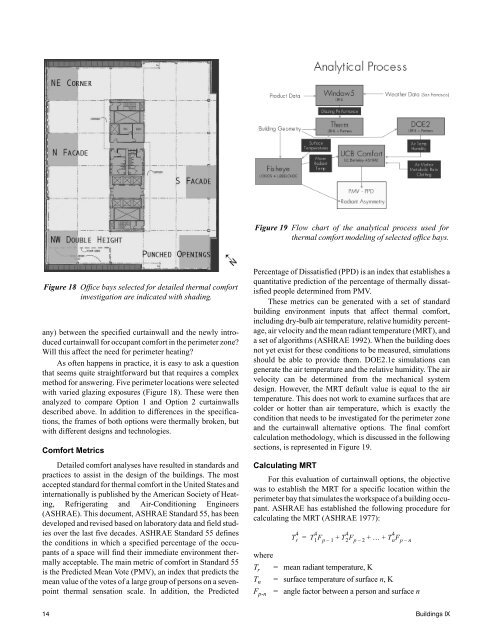A Case Study in Integrated Design: Modeling for High-Performance ...
A Case Study in Integrated Design: Modeling for High-Performance ...
A Case Study in Integrated Design: Modeling for High-Performance ...
Create successful ePaper yourself
Turn your PDF publications into a flip-book with our unique Google optimized e-Paper software.
Figure 18 Office bays selected <strong>for</strong> detailed thermal com<strong>for</strong>t<br />
<strong>in</strong>vestigation are <strong>in</strong>dicated with shad<strong>in</strong>g.<br />
any) between the specified curta<strong>in</strong>wall and the newly <strong>in</strong>troduced<br />
curta<strong>in</strong>wall <strong>for</strong> occupant com<strong>for</strong>t <strong>in</strong> the perimeter zone?<br />
Will this affect the need <strong>for</strong> perimeter heat<strong>in</strong>g?<br />
As often happens <strong>in</strong> practice, it is easy to ask a question<br />
that seems quite straight<strong>for</strong>ward but that requires a complex<br />
method <strong>for</strong> answer<strong>in</strong>g. Five perimeter locations were selected<br />
with varied glaz<strong>in</strong>g exposures (Figure 18). These were then<br />
analyzed to compare Option 1 and Option 2 curta<strong>in</strong>walls<br />
described above. In addition to differences <strong>in</strong> the specifications,<br />
the frames of both options were thermally broken, but<br />
with different designs and technologies.<br />
Com<strong>for</strong>t Metrics<br />
Detailed com<strong>for</strong>t analyses have resulted <strong>in</strong> standards and<br />
practices to assist <strong>in</strong> the design of the build<strong>in</strong>gs. The most<br />
accepted standard <strong>for</strong> thermal com<strong>for</strong>t <strong>in</strong> the United States and<br />
<strong>in</strong>ternationally is published by the American Society of Heat<strong>in</strong>g,<br />
Refrigerat<strong>in</strong>g and Air-Condition<strong>in</strong>g Eng<strong>in</strong>eers<br />
(ASHRAE). This document, ASHRAE Standard 55, has been<br />
developed and revised based on laboratory data and field studies<br />
over the last five decades. ASHRAE Standard 55 def<strong>in</strong>es<br />
the conditions <strong>in</strong> which a specified percentage of the occupants<br />
of a space will f<strong>in</strong>d their immediate environment thermally<br />
acceptable. The ma<strong>in</strong> metric of com<strong>for</strong>t <strong>in</strong> Standard 55<br />
is the Predicted Mean Vote (PMV), an <strong>in</strong>dex that predicts the<br />
mean value of the votes of a large group of persons on a sevenpo<strong>in</strong>t<br />
thermal sensation scale. In addition, the Predicted<br />
Figure 19 Flow chart of the analytical process used <strong>for</strong><br />
thermal com<strong>for</strong>t model<strong>in</strong>g of selected office bays.<br />
Percentage of Dissatisfied (PPD) is an <strong>in</strong>dex that establishes a<br />
quantitative prediction of the percentage of thermally dissatisfied<br />
people determ<strong>in</strong>ed from PMV.<br />
These metrics can be generated with a set of standard<br />
build<strong>in</strong>g environment <strong>in</strong>puts that affect thermal com<strong>for</strong>t,<br />
<strong>in</strong>clud<strong>in</strong>g dry-bulb air temperature, relative humidity percentage,<br />
air velocity and the mean radiant temperature (MRT), and<br />
a set of algorithms (ASHRAE 1992). When the build<strong>in</strong>g does<br />
not yet exist <strong>for</strong> these conditions to be measured, simulations<br />
should be able to provide them. DOE2.1e simulations can<br />
generate the air temperature and the relative humidity. The air<br />
velocity can be determ<strong>in</strong>ed from the mechanical system<br />
design. However, the MRT default value is equal to the air<br />
temperature. This does not work to exam<strong>in</strong>e surfaces that are<br />
colder or hotter than air temperature, which is exactly the<br />
condition that needs to be <strong>in</strong>vestigated <strong>for</strong> the perimeter zone<br />
and the curta<strong>in</strong>wall alternative options. The f<strong>in</strong>al com<strong>for</strong>t<br />
calculation methodology, which is discussed <strong>in</strong> the follow<strong>in</strong>g<br />
sections, is represented <strong>in</strong> Figure 19.<br />
Calculat<strong>in</strong>g MRT<br />
For this evaluation of curta<strong>in</strong>wall options, the objective<br />
was to establish the MRT <strong>for</strong> a specific location with<strong>in</strong> the<br />
perimeter bay that simulates the workspace of a build<strong>in</strong>g occupant.<br />
ASHRAE has established the follow<strong>in</strong>g procedure <strong>for</strong><br />
calculat<strong>in</strong>g the MRT (ASHRAE 1977):<br />
where<br />
Tr = mean radiant temperature, K<br />
Tn = surface temperature of surface n, K<br />
Fp-n = angle factor between a person and surface n<br />
14 Build<strong>in</strong>gs IX<br />
4<br />
Tr 4 4 4<br />
=<br />
T1Fp – 1 + T2Fp – 2 + … + TnFp – n

















